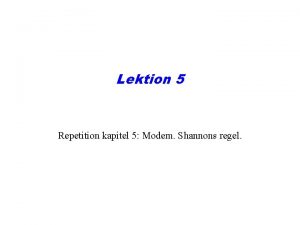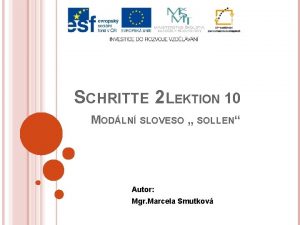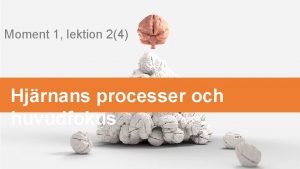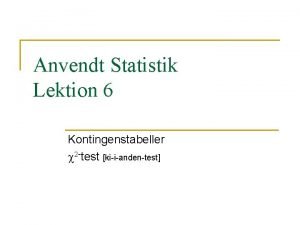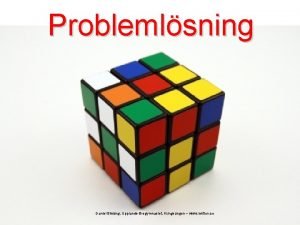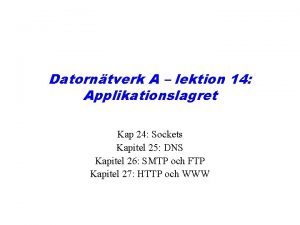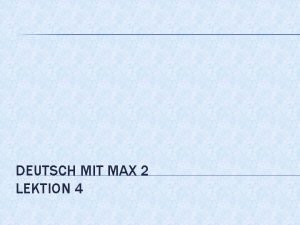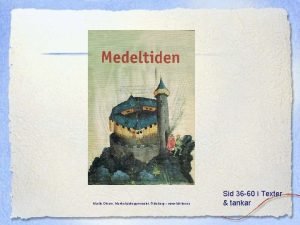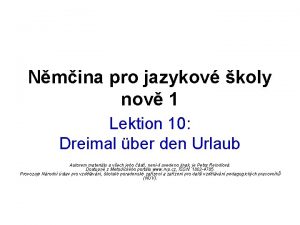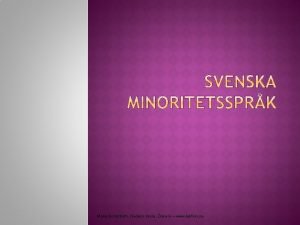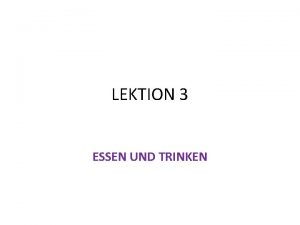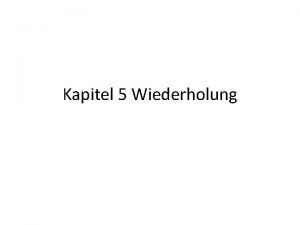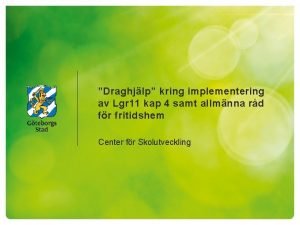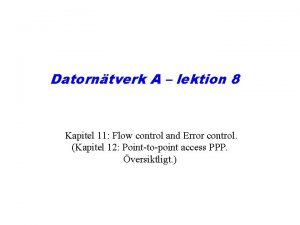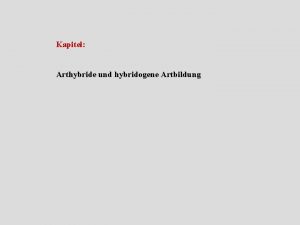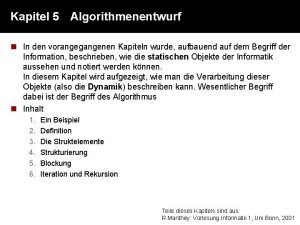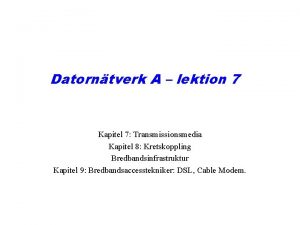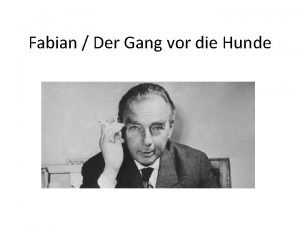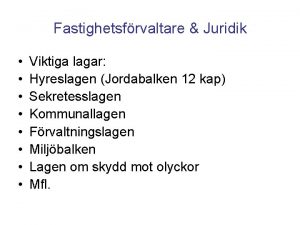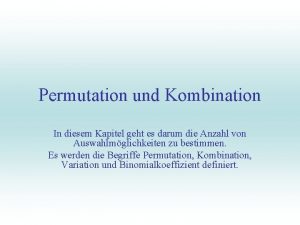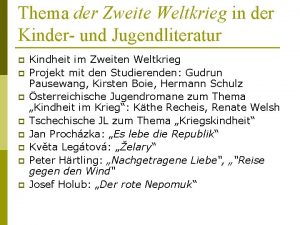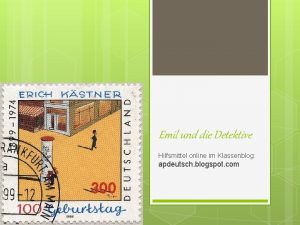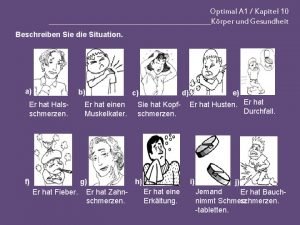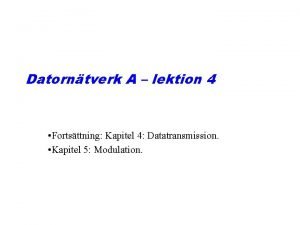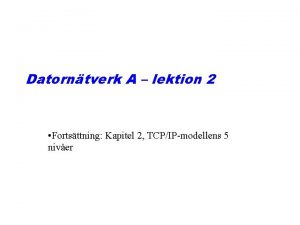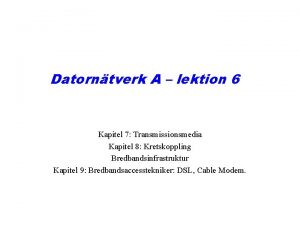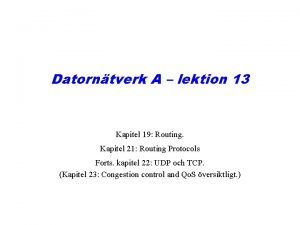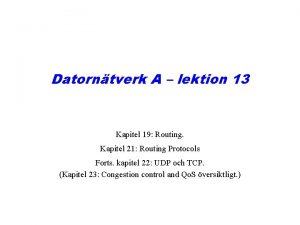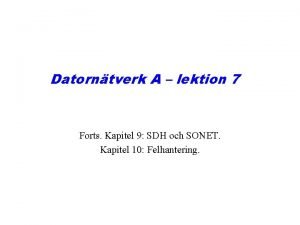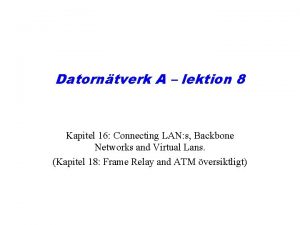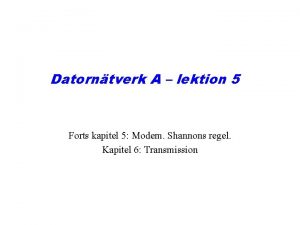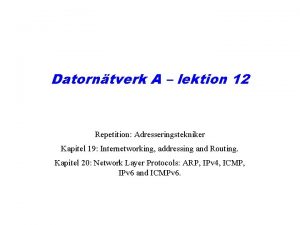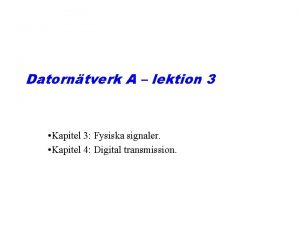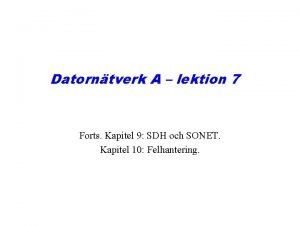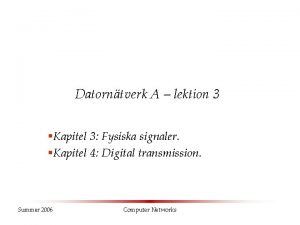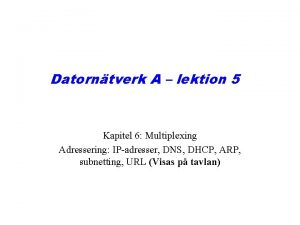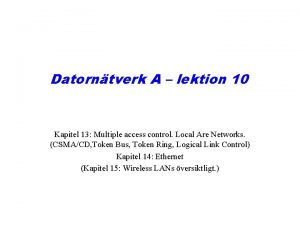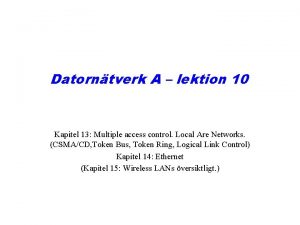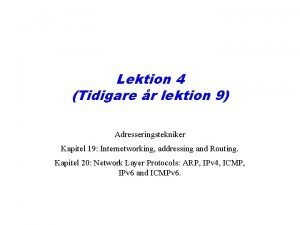Datorntverk A lektion 4 Fortsttning Kapitel 4 Datatransmission






























































- Slides: 62

Datornätverk A – lektion 4 • Fortsättning: Kapitel 4: Datatransmission. • Kapitel 5: Modulation.

Figure 4. 24 Data transmission

Figure 4. 25 Parallel transmission

Figure 4. 26 Serial transmission

Note: In asynchronous transmission, we send 1 start bit (0) at the beginning and 1 or more stop bits (1 s) at the end of each byte. There may be a gap between each byte.

Note: Asynchronous here means “asynchronous at the byte level, ” but the bits are still synchronized; their durations are the same.

Figure 4. 27 Asynchronous transmission

Exempel på asynkron seriekommunikation: RS 232 C (”comporten”)

Note: In synchronous transmission, we send bits one after another without start/stop bits or gaps. It is the responsibility of the receiver to group the bits.

Figure 4. 28 Synchronous transmission

Duplex och simplex • Simplex = enkelriktad kommunikation. • Halv duplex = dubbelriktad kommunikation, en riktning i taget. Exempel: ○ Komradio. ○ 2 -trådig Ethernet. ○ Radio-LAN. • Full duplex = dubbelriktad kommunikation, t. ex. över seriell 4 trådsförbindelse. Exempel: ○ Mobiltelefoner. En kanalfrekvens i upplänk, en annan i nedlänk. ○ 4 -trådig Ethernet. ○ Telefonnätets modem. (Trots att telefonnätet bara är 2 -trådigt. Modemen innehåller en s. k. gaffelkoppling som omvandlar mellan 4 -trådig och 2 -trådig kommunikation. Denna innehåller transformator och adaptiva filter som undertrycker reflektioner. )

Figure 5. 25 Types of analog-to-analog modulation

Figure 5. 26 Amplitude modulation

Figure 5. 29 Frequency modulation

Modulation och demodulation • Baudrate = antal symboler per sekund. Enhet: baud eller symboler/sekund. • Bitrate = datahastighet. Enhet: bps eller bit/s. • Vid många modulationsformer t. ex. s. k. ASK, PSK, och QAM är signalens bandbredd = symbolhastigheten. • Vid FSK är bandbredden vanligen större.

Digitala modulationsmetoder Binär signal ASK = Amplitude Shift Keying (AM) FSK = Frequency Shift Keying (FM) PSK = Phase Shift Keying (PSK)

Exempel 1: Till höger visas fyra symboler som används av ett s. k. 4 PSKmodem (PSK=Phase Shift Keying). De fyra symbolerna representerar bitföljderna 00, 01, 11 resp 10. a) Nedan visas utsignalen från det sändande modemet. Vilket meddelande, dvs vilken bitsekvens, överförs? 1 0 -1 1 Svar: 1/1 ms = 1000 symber per sekund = 1 kbaud. c) Vad är bithastigheten i bit per sekund (bps)? Svar: 2000 bps. 0 0. 5 1 time [milliseconds] 01 0 -1 Svar: 11 00 10 10. b) Tidsaxeln är graderad i tusendels sekunder. Vad är symbolhastigheten i baud eller symboler/sekund? 00 1 0 0. 5 1 time [milliseconds] 11 0 -1 1 0 0. 5 1 time [milliseconds] 10 0 -1 0 0. 5 1 time [milliseconds]

Exempel 2: Nedan visas åtta symboler som används av ett s. k. 8 QAM-modem (QAM=Quadrature Amplitude Modulation). Symbolerna i övre raden representerar bitföljderna 000, 001, 011 resp 010 (från vänster till höger). Undre raden representerar 100, 101, 111 resp 110.

Forts exempel 2:

Example 1 An analog signal carries 4 bits in each signal unit. If 1000 signal units are sent per second, find the baud rate and the bit rate Solution Baud rate = 1000 bauds per second (baud/s) Bit rate = 1000 x 4 = 4000 bps

Figure 5. 4 Relationship between baud rate and bandwidth in ASK

Figure 5. 3 ASK

Example 3 Find the minimum bandwidth for an ASK signal transmitting at 2000 bps. The transmission mode is halfduplex. Solution In ASK the baud rate and bit rate are the same. The baud rate is therefore 2000. An ASK signal requires a minimum bandwidth equal to its baud rate. Therefore, the minimum bandwidth is 2000 Hz.

Example 4 Given a bandwidth of 5000 Hz for an ASK signal, what are the baud rate and bit rate? Solution In ASK the baud rate is the same as the bandwidth, which means the baud rate is 5000. But because the baud rate and the bit rate are also the same for ASK, the bit rate is 5000 bps.

Example 6 Find the minimum bandwidth for an FSK signal transmitting at 2000 bps. Transmission is in half-duplex mode, and the carriers are separated by 3000 Hz. Solution For FSK BW = baud rate + fc 1 - fc 0 BW = bit rate + fc 1 - fc 0 = 2000 + 3000 = 5000 Hz

Example 7 Find the maximum bit rates for an FSK signal if the bandwidth of the medium is 12, 000 Hz and the difference between the two carriers is 2000 Hz. Transmission is in full-duplex mode. Solution Because the transmission is full duplex, only 6000 Hz is allocated for each direction. BW = baud rate + fc 1 - fc 0 Baud rate = BW - (fc 1 - fc 0 ) = 6000 - 2000 = 4000 But because the baud rate is the same as the bit rate, the bit rate is 4000 bps.

Figure 5. 8 PSK

Figure 5. 5 Solution to Example 5

Figure 5. 6 FSK

Figure 5. 9 PSK constellation

Figure 5. 10 The 4 -PSK method

Figure 5. 11 The 4 -PSK characteristics

Figure 5. 12 The 8 -PSK characteristics

Figure 5. 13 Relationship between baud rate and bandwidth in PSK

Example 9 Given a bandwidth of 5000 Hz for an 8 -PSK signal, what are the baud rate and bit rate? Solution For PSK the baud rate is the same as the bandwidth, which means the baud rate is 5000. But in 8 -PSK the bit rate is 3 times the baud rate, so the bit rate is 15, 000 bps.

Note: Quadrature amplitude modulation is a combination of ASK and PSK so that a maximum contrast between each signal unit (bit, dibit, tribit, and so on) is achieved.

Figure 5. 14 The 4 -QAM and 8 -QAM constellations

Figure 5. 15 Time domain for an 8 -QAM signal

Figure 5. 16 16 -QAM constellations

Figure 5. 17 Bit and baud

Table 5. 1 Bit and baud rate comparison Modulation Units Bits/Baud rate Bit Rate Bit 1 N N 4 -PSK, 4 -QAM Dibit 2 N 2 N 8 -PSK, 8 -QAM Tribit 3 N 3 N 16 -QAM Quadbit 4 N 4 N 32 -QAM Pentabit 5 N 5 N 64 -QAM Hexabit 6 N 6 N 128 -QAM Septabit 7 N 7 N 256 -QAM Octabit 8 N 8 N ASK, FSK, 2 -PSK

Example 10 A constellation diagram consists of eight equally spaced points on a circle. If the bit rate is 4800 bps, what is the baud rate? Solution The constellation indicates 8 -PSK with the points 45 degrees apart. Since 23 = 8, 3 bits are transmitted with each signal unit. Therefore, the baud rate is 4800 / 3 = 1600 baud

Example 11 Compute the bit rate for a 1000 -baud 16 -QAM signal. Solution A 16 -QAM signal has 4 bits per signal unit since log 216 = 4. Thus, 1000· 4 = 4000 bps

Example 12 Compute the baud rate for a 72, 000 -bps 64 -QAM signal. Solution A 64 -QAM signal has 6 bits per signal unit since log 2 64 = 6. Thus, 72000 / 6 = 12, 000 baud

5. 2 Telephone Modems Modem Standards

Note: A telephone line has a bandwidth of almost 2400 Hz for data transmission.

Figure 5. 18 Telephone line bandwidth

Note: Modem stands for modulator/demodulator.

Figure 5. 19 Modulation/demodulation

Figure 5. 20 The V. 32 constellation and bandwidth

Figure 5. 21 The V. 32 bis constellation and bandwidth

Figure 5. 22 Traditional modems

Figure 5. 23 56 K modems

5. 3 Modulation of Analog Signals Amplitude Modulation (AM) Frequency Modulation (FM) Phase Modulation (PM)

Figure 5. 24 Analog-to-analog modulation

Note: The total bandwidth required for AM can be determined from the bandwidth of the audio signal: BWt = 2 x BWm.

Example 7 Consider a noiseless channel with a bandwidth of 3000 Hz transmitting a signal with two signal levels. The maximum bit rate can be calculated as Bit Rate = 2 3000 log 2 2 = 6000 bps

Shannons regel Kanalkapaciteten C är max antal bit per sekund vid bästa möjliga modulationsteknik och felrättande kodning: C = B log 2 (1+S/N), där B är ledningens bandbredd i Hertz (oftast ungefär lika med övre gränsfrekvensen), S är nyttosignalens medeleffekt i Watt och N (noice) är bruseffekten i Watt.

Example 8 Consider the same noiseless channel, transmitting a signal with four signal levels (for each level, we send two bits). The maximum bit rate can be calculated as: Bit Rate = 2 x 3000 x log 2 4 = 12, 000 bps

Example 9 Consider an extremely noisy channel in which the value of the signal-to-noise ratio is almost zero. In other words, the noise is so strong that the signal is faint. For this channel the capacity is calculated as C = B log 2 (1 + SNR) = B log 2 (1 + 0) = B log 2 (1) = B 0 = 0

Example 10 We can calculate theoretical highest bit rate of a regular telephone line. A telephone line normally has a bandwidth of 3000 Hz (300 Hz to 3300 Hz). The signal-to -noise ratio is usually 3162. For this channel the capacity is calculated as C = B log 2 (1 + SNR) = 3000 log 2 (1 + 3162) = 3000 log 2 (3163) C = 3000 11. 62 = 34, 860 bps

Example 11 We have a channel with a 1 MHz bandwidth. The SNR for this channel is 63; what is the appropriate bit rate and signal level? Solution First, we use the Shannon formula to find our upper limit. C = B log 2 (1 + SNR) = 106 log 2 (1 + 63) = 106 log 2 (64) = 6 Mbps Then we use the Nyquist formula to find the number of signal levels. 4 Mbps = 2 1 MHz log 2 L L = 4
 Kapitel 5 lektion a answers
Kapitel 5 lektion a answers Schritte international 2 test zu lektion 10
Schritte international 2 test zu lektion 10 Lektion.se
Lektion.se Lektion 6
Lektion 6 Lektion 24
Lektion 24 Kontingenstabel
Kontingenstabel Lektion se
Lektion se Lektion 2
Lektion 2 Lektion 14
Lektion 14 Deutsch mit max 2 download
Deutsch mit max 2 download Helvetestratten
Helvetestratten Lektion 10
Lektion 10 Magnesiumsulfid
Magnesiumsulfid Heden dinosaurier
Heden dinosaurier Lektion,se
Lektion,se Infinitiv
Infinitiv Malin nielsen
Malin nielsen Eriksdalskolan
Eriksdalskolan Lektion des lebens
Lektion des lebens Lektion 3 essen und trinken
Lektion 3 essen und trinken Good pizza great pizza kapitel 3
Good pizza great pizza kapitel 3 Markus kapitel 16
Markus kapitel 16 Lgr 11 kap 4
Lgr 11 kap 4 Perfekt 1 kapitel 4
Perfekt 1 kapitel 4 Control kapitel
Control kapitel Arthybride
Arthybride Iso 9001 kapitel 8
Iso 9001 kapitel 8 Im vorangegangenen kapitel
Im vorangegangenen kapitel Brief an die galater kapitel 6
Brief an die galater kapitel 6 The australian connection zusammenfassung kapitel 7
The australian connection zusammenfassung kapitel 7 Ronja räubertochter buch zusammenfassung
Ronja räubertochter buch zusammenfassung 1. brief an die korinther kapitel 13
1. brief an die korinther kapitel 13 Fabian oder der gang vor die hunde wien
Fabian oder der gang vor die hunde wien Bitterschokolade buch kapitel zusammenfassung
Bitterschokolade buch kapitel zusammenfassung Hiob kapitel 42
Hiob kapitel 42 Fliegender stern kapitel 5
Fliegender stern kapitel 5 12 kap 4 § jordabalken
12 kap 4 § jordabalken Wie viele wörter sind das
Wie viele wörter sind das Markusevangelium kapitel 10
Markusevangelium kapitel 10 Kallocain handling
Kallocain handling Elischka
Elischka Emil und die detektive kapitel 12 zusammenfassung
Emil und die detektive kapitel 12 zusammenfassung Kapitel
Kapitel Das doppelte lottchen kapitel zusammenfassung
Das doppelte lottchen kapitel zusammenfassung
